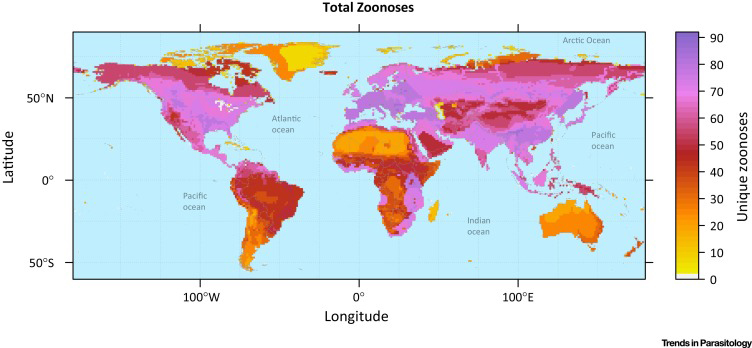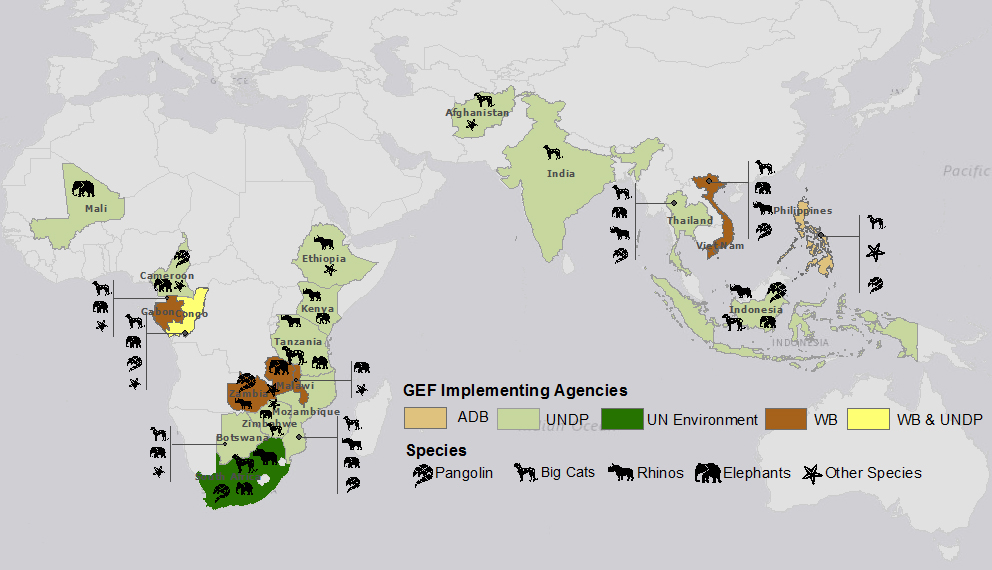Programs combating Illegal Wildlife Trade are instrumental in controlling and preventing pandemics
The current COVID-19 pandemic is a zoonosis- a disease or infection that is naturally transmissible from animals to humans and can be caused by viruses, bacteria, parasites, or unconventional agents. Infection is spread through direct and indirect contact, through vectors, and contaminated food and water. Zoonotic diseases today account for around sixty percent of all emerging infectious diseases, and seventy-one percent of these originate in wildlife.

Figure 1: Overlapping Geographic Ranges of Zoonotic Diseases Carried by Wild Terrestrial Mammal Host Species (Source: Han et al. 2016)
Scientists agree that the rate of emergence of zoonoses is increasing. Some of the deadliest infectious diseases—Ebola, bird flu, the Middle East respiratory syndrome (MERS), severe acute respiratory syndrome (SARS), West Nile virus, and Zika are zoonoses. The SARS coronavirus spread from bats to farmed civet cats to humans. Researchers have suggested that pangolins, a critically endangered species, and one of the most widely and illegally traded animals, probably played a role in the transmission of COVID-19 from bats to humans.
Land use mismanagement, habitat loss, and overexploitation of wildlife—in a changing climate have created multiple pathways for pathogens to transmit from wildlife to domestic animals and humans. The link between Ebola outbreaks and forest loss and fragmentation is well documented. Experts suggest that habitat destruction and removal of prey species, such as large mammals, through hunting may change the balance between pathogens and hosts, and their natural circulation.
Wildlife trade—both legal and illegal—is another transmission pathway that exposes humans to zoonotic diseases. The supply chain of wildlife and wildlife products from source areas, transportation through local, national, and international networks to distant markets allows for natural spillover and spread. Practices, including unsafe handling, allow pathogens to pass from wildlife to humans. The conditions and practices are far more challenging to monitor and impossible to regulate in the illegal wildlife trade. Unfortunately, illegal wildlife trade generates USD 26 billion per year, making it the fourth most profitable illegal industry in the world. Stopping illegal trade has been a taxing endeavor, and as long as there is a demand for wildlife products, there will be trade.
A Soup to Nuts Approach in addressing Illegal Wildlife Trade
The Global Environment Facility (GEF) has been supporting biodiversity conservation since its establishment in 1991 as the financial mechanism for the UN Convention on Biological Diversity. The GEF's first effort to tackle illegal wildlife trade in a coordinated and comprehensive manner was through the Global Partnership on Wildlife Conservation and Crime Prevention for Sustainable Development in 2015, covering 19 countries in Asia and Africa (Figure 2). The Program aims to prevent the extinction of threatened species by reducing poaching, reducing trafficking and demand reduction. Main interventions included supporting protected area management, reducing poaching of target species, engaging communities and managing human-wildlife conflict, improving performance across the enforcement and criminal justice chain, establishing partnerships, and knowledge management.
The Independent Evaluation Office (IEO) of the GEF conducted a formative assessment of the Program in 2017. The program was at early stages of implementation and provided insights into what works, why, and under what circumstances, for whom, and how much. The lessons learned from formative assessment allowed for timely improvements in ongoing implementation of the program.

Figure 2: Countries and the iconic species addressed by the GEF-funded program. The program has now been extended to include more countries and species.
Lessons for Pandemics
The COVID-19 outbreak has highlighted the issue of illegal wildlife trade and more broadly of habitat destruction and biodiversity loss. While we maintain our current focus on the immediate medical, health, and socioeconomic needs, we need to prepare better to address and mitigate risks to environmental health and human well-being posed by climate change, biodiversity loss, and deforestation and degradation. The evaluation of GEF's Illegal Wildlife Trade Program demonstrated the need for a comprehensive approach along the entire supply chain from sources to global markets to avoid spread—the source of wildlife traded illegally, the shipment and transportation of wildlife and wildlife products, and the market demand for those products.
Evaluation lessons point to the need for:
- A globally coordinated approach. Often, initiatives are designed for single countries. Illegal wildlife trade by nature permeates through jurisdictional boundaries, thus dictating cross-boundary strategies at the regional and global scale. IWT is ultimately an international issue, and combatting IWT irequires a more cohesive approach with the inclusion of regional initiatives, cross-border activities within nationally implemented projects, and coordination among countries on transboundary issues.
- Greater attention to a broader spectrum of illegally traded species. Most programs are found to be limited to certain threatened and endangered species and megafaunas. Species coverage needs to be strategically expanded for the conservation of the maximum number of species and saving species from extinction. The GEF subsequently addressed this gap in the follow on funding phase with the expansion of interventions to include additional species. A recent study also found that the propensity to transmit a zoonotic disease varies minimally among animal groups. Paying attention to more species, therefore, also assumes importance for public health surveillance and assessing zoonotic risk.
- Appropriate focus on demand countries. Most interventions typically focus on reducing poaching of wildlife in source countries and anti-trafficking of illegal wildlife and derived products. Only a few initiatives we observed focus on reducing demand for illegally traded wildlife in Asia, the EU, and the United States. Interventions to combat IWT should focus more on demand reduction. China has banned all forms of illegal wildlife trade and consumption in the context of the current pandemic and in response to growing indications that the COVID-19 outbreak stemmed from a coronavirus found in wildlife. This response highlights the linkage between IWT and zoonoses, and the importance of working with countries with the most demand for wildlife and wildlife products.
- Explicitly addressing political will and corruption. A coordinated focus on political will and corruption will ultimately help strengthen the legislation, law enforcement, and judicial systems to combat IWT.
- Enhancing livelihoods. IWT is driven, in large part, by growing demand from expanding economies in Asia often facilitated by transnational criminal networks. Communities are forced to engage in poaching due to poverty and the absence of sustainable livelihoods. Efforts should focus on livelihood security of people living near wildlife coupled with demand reduction strategies, which include public awareness and behavior change campaigns in major market hubs.




